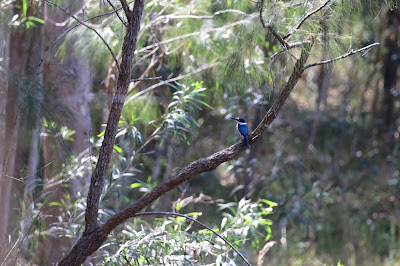With the warmer weather came the Dragonflies and I've begun to get a glimpse of just how many species there are and how beautiful some of them can be. In a moment of imprudence I splashed out on the CSIRO's The Complete Field Guide to Dragonflies of Australia and am now beginning to get the hang of identifying them, I have to admit, it ain't easy. The guides' photographs are not always brilliant and the accompanying notes often refers to parts of the insects anatomy that I was completely unaware of. Still, they are beautiful beasties and can be quite obliging to the photographer as many will sit happily on a perch whilst I find my focus. Some species of Dragonflies prefer to sit on vegetation, whilst others prefer rocks or dry ground and only a few (thankfully) rarely stop at all. The first trick is to differentiate between Dragonflies and Damselflies. The former tend to be larger, have eyes that touch and sit with wings stretched out,
 |
| This Graphic Flutterer is a good example of a Dragonfly. Eyes almost touching and wings spread. |
 |
| Whereas this little fellow is a classic Damselfly with separated eyes and wings held along the line of the body. |
I will stress that these are general rules and certain species ignore them.
 |
| A Scarlet Percher - Dragonfly |
 |
| An Emerald Tau - Dragonfly |
 |
| Southern Whitetip - Damselfly |
 |
| Black-headed Skimmer - Dragonfly |
 |
| Scarlet Percher - Dragonfly |
 |
| Blue Skimmer - Dragonfly |
and a Blue Skimmer perching on a reed.
 |
| Billabongfly - Damselfly |
 |
| female Blue Skimmer - Dragonfly |
It seems quite common that females appear in a yellow colour.
 |
| Yellow & Black Flutterer - Dragonfly |
 |
| Fairy Wisp - Damselfly |
 |
| Orange Threadtails - Damselfly |
 |
| L-spot Basker - Dragonfly |
At which point we'll move onto the birds.
Regulars (seen at least 5 days in the week)
Australian Magpie
Bar-shouldered Dove
Bronzewing
Channel-billed Cuckoo
Double-barred Finch
Galah
King Parrot
 |
| Male King Parrot |
Laughing Kookaburra
Little Corella
Little Friarbird
Noisy FriarbirdOlive-backed Oriole
Pacific Black Duck
Peaceful Dove
Pied Butcherbird
Pied Currawong
Plumed Whistling Duck
 |
| A group of Plumed Whistling Ducks taking it in turns at the water fountain on the pump raft, |
Rainbow Lorikeet
Sulphur Crested Cockatoo
Torresian Crow
Yellow-faced Honeyeater
White-throated Gerygone
Common (Seen at least twice a week)
Pale Headed Rosella
Noisy Miner
Spangled Drongo
White-throated Honeyeater
Wood Duck
Uncommon (Seen two to five times during the month)
Black-faced Cuckoo Shrike
Brown Cuckoo DoveBrown Honeyeater
Collared Sparrowhawk
 |
| Collared Sparrowhawk |
Grey Shrike Thrush
 |
| The Grey Shrike Thrush - dull colours but an amazing voice. |
Red-backed Fairy Wren
Welcome Swallow
White-faced Heron
Rare (Seen only once)
Buff-rumped Thornbill
 |
| A Buff-rumped Thornbill |
Common Mynah
Crested Pigeon
 |
| Crested Pigeon |
Dollarbird
Eastern Yellow Robin
 |
| A pair of Eastern Yellow Robins that have successfully mated and now have two fledglings. |
Figbird
Leaden Flycatcher
Satin Flycatcher
Southern Boobook
White-bellied Cuckoo Shrike
Willie Wagtail
Yellow-rumped Thornbill
Which totals 50-species, well below last year, but I have been busy with guests and work so I haven't spent quite as much time in the garden. Let's see what happens in December.



































